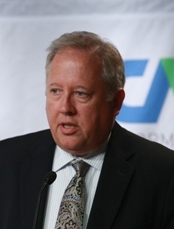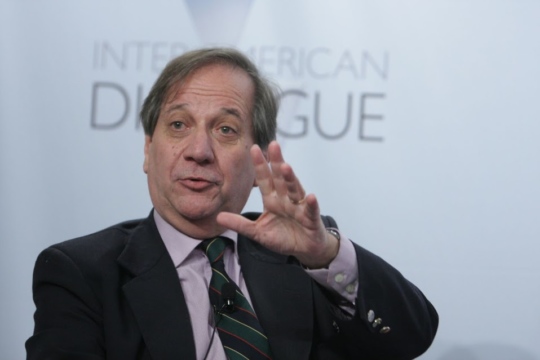
An Americas Agenda for the World
The Inter-American Democratic Charter is a watershed in how the region understands democracy.
At the 26th Annual CAF Conference from June 1-2, 2023, the Inter-American Dialogue, CAF-Development Bank of Latin America and the Caribbean, and the Organization of American States convened experts for a panel titled “Making Migration and Growth Work Together.” Andrew Selee, president of the Migration Policy Institute, Kelly Gallego Massaro, president of ABRACAM-Associação Brasileira de Câmbio, and Sergio Sagastume, CEO of Amigo Paisano joined Manuel Orozco, director of the Migration and Remittances Program at the Inter-American Dialogue for this important panel.
The third panel of the conference focused on how migration in the Americas can be leveraged to boost economic growth and improve competitiveness by strengthening payment networks and attracting investments in housing and businesses. Orozco opened the session by outlining the changing landscape of migration, characterized not just by a sharp increase from around 33 million migrants in 2015 to 45 million today, but also by other dynamics such as the growing number of migrants who are minors and the fact that most outflows are coming from fragile states like Venezuela, Cuba, Haiti, Nicaragua, Honduras, El Salvador, and Guatemala. This shows that the drivers of migration are not just economic, but also political, Orozco said, while highlighting how migration is at the center of the intersection between individuals and the state. This manifests itself through remittances, which amount to 5 percent of LAC’s gross domestic product, and through migrant-driven consumption. Orozco pointed out that there is a sort of perversity to this dynamic, in which people who are forced out of their countries end up boosting the origin country’s economy – and the very governments that drove them out in the first place – through remittances.
Selee agreed that this idea of the interconnection of migration and development has been gaining traction in recent years. Whereas two decades ago Washington was concerned with Mexican migration, the reality today is that migration is intraregional – not only to the United States – and that migrants are coming from multiple countries across the region, and even from outside the hemisphere. Most importantly, it has become clear that migratory dynamics matter on the development front. For example, in Guatemala, almost every municipality has a private university, made possible by remittances. This shows you that migration is having a positive impact on households’ living standards, allowing people to invest in education and health, Selee said. At the same time, he added, it is telling that these vehicles for development are not provided for by the state. His concern is that, while remittance payments are important to households, they are not a development strategy in and of themselves. In this regard, there is growing awareness of the need to add components that are missing to transform remittances into concrete solutions to on-the-ground problems and harness these synergies to drive local development.
Gallego then spoke to the Brazilian experience, highlighting that there is a strong culture of both immigration and outmigration in the country. However, when thinking about migration in Brazil, she said, there are certain particularities that are important to consider. For one, remittances constitute less than 1 percent of Brazilian GDP, compared to other economies in the region where they amount to almost 20 percent. Additionally, there is a framework in place that allows migrants access to health, education, housing, and even social programs. At the same time, Brazil has an extensive land border, and for this reason, it is often a transit country and functions as a place where migrants can acquire sufficient financial stability to continue to their final destination, Gallego explained. This is in part because everyone in Brazil has access to the country’s digital payments system – the PIX – which allows for better financial inclusion and reduces remittance fees.
Sagastume expanded on the topic of financial inclusion and migrants’ demand for financial services, outlining how the nature of money transfers has also changed over time. In the 1980s and 1990s, migrants sent transfers home through money orders, a model that was disrupted by technology, with consumers increasingly opting for easier, quicker, and less expensive digital transfers instead. This is where the future is headed, Sagastume said, and the challenge here is ensuring that individuals have access to bank accounts with digital payments options to accelerate and facilitate remittances. Orozco agreed, adding that peoples’ needs have really been driving this increase in demand for digital banking and constantly changing the dynamics of money transfers.
The session ended with a discussion on how undocumented migrants feature into these conversations. Gallego explained that, in Brazil, undocumented migrants can access digital payments using only their passport without any legal impediment. Selee added to this by recognizing that Brazil has been an example in the region in terms of facilitating legal status to undocumented migrants. Argentina and Uruguay also have special pathways to legal status for Venezuelans specifically, Selee said, and most countries in the region have made strides in this regard – the problem is that the type of legal status that migrants are afforded does not always allow for access to the banking system, but that is changing. In the United States, undocumented migrants have access to money transfers, but they usually send smaller amounts, as their earning ability is limited by their legal status. Sagastume emphasized how the acceleration of digital banking since the Covid-19 pandemic has contributed substantially to migrants’ financial inclusion by helping shift their attitude toward the banking system. Orozco closed by acknowledging the role that the private banking sector can play a role in this regard, for example, by adapting regulations that facilitate financial pathways to formalized savings for undocumented migrants, without the need for legal status.
The Inter-American Democratic Charter is a watershed in how the region understands democracy.
Summary of the XIV Annual CAF Conference
Regional integration, social inclusion, and the need for a more competitive business climate—discussed at the XVIII Annual CAF Conference
 Jay Mallin
Jay Mallin

 Video
Video